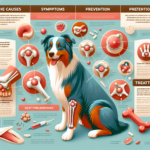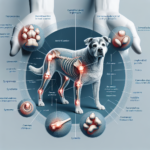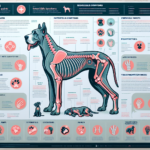Bedlington Terrier Joint Pain: Causes, Symptoms, Prevention, and Treatment

Introduction
The Bedlington Terrier is a unique and charming breed known for its lamb-like appearance and spirited personality. Originating from the mining town of Bedlington in Northumberland, England, this breed was initially developed for hunting vermin and later became a beloved companion dog. Bedlington Terriers are characterized by their distinctive curly coat, arched back, and pear-shaped head. They are known for their agility, intelligence, and affectionate nature, making them excellent family pets.
Like many purebred dogs, Bedlington Terriers are prone to certain health issues. Among these, joint pain is a significant concern that can affect their quality of life. Joint pain in dogs can stem from various causes, including genetic predispositions, age-related wear and tear, and lifestyle factors. Understanding the causes, symptoms, prevention, and treatment of joint pain in Bedlington Terriers is crucial for ensuring their long-term health and well-being.
Joint health is particularly important for Bedlington Terriers due to their active nature and physical structure. Maintaining healthy joints can help prevent pain and mobility issues, allowing these energetic dogs to enjoy a full and active life.
Breed-Specific Joint Pain Risks
Genetic Predisposition
Bedlington Terriers, like many purebred dogs, have a genetic predisposition to certain joint-related issues. Hip dysplasia, a condition where the hip joint does not fit properly into the hip socket, is one such concern. This can lead to arthritis and significant pain over time. Elbow dysplasia, another genetic condition, affects the elbow joint and can also result in arthritis and chronic pain. These genetic predispositions make it essential for breeders to screen for these conditions and for owners to be vigilant about their dog’s joint health.
Age-Related Risks
As Bedlington Terriers age, they become more susceptible to joint pain and related issues. The wear and tear on their joints can lead to conditions such as osteoarthritis, which is characterized by the degeneration of joint cartilage. This breed typically begins to show signs of joint pain as they enter their senior years, around 7-10 years of age. However, early onset of joint issues can occur, especially if the dog has a genetic predisposition or has experienced joint injuries.
Activity Level and Joint Stress
Bedlington Terriers are known for their high energy levels and love for physical activities. While regular exercise is essential for their overall health, excessive or inappropriate exercise can put undue stress on their joints. Activities that involve jumping, running on hard surfaces, or sudden changes in direction can increase the risk of joint injuries. It’s important for owners to balance their dog’s activity level with their joint health needs to prevent overexertion and potential joint damage.
Common Symptoms of Joint Pain in Bedlington Terriers
General Symptoms
Owners should be aware of the common symptoms of joint pain in Bedlington Terriers, which include:
- Limping: A noticeable limp or favoring one leg over another can indicate joint pain.
- Stiffness: Difficulty in getting up, especially after resting, is a common sign of joint issues.
- Reluctance to Move: A dog that is hesitant to jump, climb stairs, or engage in physical activities may be experiencing joint pain.
- Swelling: Visible swelling around the joints can be a sign of inflammation and pain.
- Behavioral Changes: Increased irritability, lethargy, or changes in appetite can also be indicators of discomfort.
Breed-Specific Symptoms
In Bedlington Terriers, joint pain may manifest in specific ways due to their unique physical structure. For example, their arched back may make them more prone to spinal issues, which can contribute to joint pain. Additionally, their active nature means that any reluctance to engage in play or exercise is a significant red flag that should not be ignored.
When to Consult a Vet
If you notice any of the above symptoms in your Bedlington Terrier, it’s important to consult a veterinarian promptly. Early diagnosis and intervention can help manage joint pain more effectively and prevent further deterioration. Regular veterinary check-ups are also crucial for monitoring your dog’s joint health and catching any issues early on.
Preventive Measures for Joint Health
Exercise Recommendations
Maintaining an appropriate exercise routine is key to preventing joint pain in Bedlington Terriers. Low-impact exercises such as walking, swimming, and controlled play are ideal for keeping their joints healthy without causing excessive stress. Avoid activities that involve high jumps or sudden changes in direction, as these can increase the risk of joint injuries. Consistent, moderate exercise helps maintain muscle strength and joint flexibility.
Dietary Suggestions
A balanced diet rich in essential nutrients is vital for supporting joint health. Consider incorporating foods or supplements that contain glucosamine, chondroitin, and omega-3 fatty acids, as these have been shown to promote joint health and reduce inflammation. High-quality commercial dog foods often include these nutrients, but you can also consult your veterinarian for specific dietary recommendations tailored to your Bedlington Terrier’s needs.
Weight Management
Maintaining a healthy weight is crucial for reducing joint stress in Bedlington Terriers. Excess weight puts additional pressure on the joints, exacerbating pain and increasing the risk of joint-related issues. Monitor your dog’s weight regularly and adjust their diet and exercise routine as needed to keep them at an optimal weight. Your veterinarian can provide guidance on the ideal weight range for your dog based on their age, size, and activity level.
Early Screening and Monitoring
Early screening and regular monitoring are essential for catching joint issues before they become severe. Genetic testing for conditions like hip and elbow dysplasia can help identify potential risks early on. Regular veterinary check-ups, including physical examinations and X-rays, can help monitor your dog’s joint health and detect any changes that may indicate the onset of joint pain.
Treatment Options for Joint Pain
Non-Surgical Treatments
For many Bedlington Terriers, non-surgical treatments can effectively manage joint pain and improve their quality of life. These treatments may include:
- Medications: Nonsteroidal anti-inflammatory drugs (NSAIDs) and pain relievers can help reduce inflammation and alleviate pain.
- Physical Therapy: Therapeutic exercises and techniques such as hydrotherapy can improve joint mobility and strengthen supporting muscles.
- Lifestyle Adjustments: Modifying your dog’s activity level and providing a comfortable living environment can help manage joint pain.
Surgical Options
In severe cases of joint pain, surgical intervention may be necessary. Common surgical options for Bedlington Terriers include:
- Joint Replacement: Total hip or elbow replacement surgery can provide significant relief for dogs with severe joint damage.
- Arthroscopy: A minimally invasive procedure that allows for the removal of damaged tissue and debris from the joint.
- Osteotomy: A surgical procedure that involves cutting and realigning bones to improve joint function and reduce pain.
Surgical options should be considered carefully and discussed with a veterinary specialist to determine the best course of action for your dog.
Alternative Therapies
Alternative therapies can complement traditional treatments and provide additional relief for joint pain. Some options include:
- Acupuncture: This ancient practice involves inserting thin needles into specific points on the body to relieve pain and promote healing.
- Hydrotherapy: Water-based exercises can improve joint mobility and reduce pain without putting stress on the joints.
- Massage: Therapeutic massage can help relax muscles, improve circulation, and alleviate joint pain.
Consult with a veterinarian experienced in alternative therapies to determine the most appropriate options for your Bedlington Terrier.
Lifestyle and Management Tips
Daily Care Routine
Establishing a daily care routine can help manage and alleviate joint pain in Bedlington Terriers. A sample routine might include:
- Morning: Gentle stretching exercises and a short walk to loosen stiff joints.
- Midday: A balanced meal with joint-supporting supplements and a brief play session.
- Afternoon: Rest time on a comfortable orthopedic bed to reduce joint pressure.
- Evening: Another short walk or low-impact activity followed by a gentle massage.
Modifying the Home Environment
Making your home more comfortable for a dog with joint pain can significantly improve their quality of life. Consider the following modifications:
- Ramps: Install ramps to help your dog navigate stairs and get onto furniture without jumping.
- Orthopedic Beds: Provide supportive beds that cushion joints and reduce pressure points.
- Non-Slip Flooring: Use rugs or mats to prevent slipping and provide better traction for your dog.
Long-Term Management
Long-term management strategies are essential for keeping your Bedlington Terrier active and happy despite joint pain. These strategies may include:
- Regular Veterinary Check-Ups: Schedule routine visits to monitor your dog’s joint health and adjust treatment plans as needed.
- Consistent Exercise: Maintain a regular exercise routine that includes low-impact activities to keep joints flexible and muscles strong.
- Ongoing Pain Management: Work with your veterinarian to manage pain through medications, supplements, and alternative therapies.
FAQs About Bedlington Terriers and Joint Pain
What are the early signs of joint pain in Bedlington Terriers?
Early signs of joint pain in Bedlington Terriers include limping, stiffness, reluctance to move, and behavioral changes such as increased irritability or lethargy. If you notice any of these symptoms, consult your veterinarian for a thorough evaluation.
Can joint pain in Bedlington Terriers be prevented?
While genetic predispositions cannot be entirely prevented, you can take steps to reduce the risk of joint pain in your Bedlington Terrier. These include maintaining a healthy weight, providing appropriate exercise, feeding a balanced diet with joint-supporting nutrients, and scheduling regular veterinary check-ups.
Are there specific exercises that are better for Bedlington Terriers with joint pain?
Low-impact exercises such as walking, swimming, and controlled play are ideal for Bedlington Terriers with joint pain. These activities help maintain joint mobility and muscle strength without putting excessive stress on the joints.
What dietary supplements can help support joint health in Bedlington Terriers?
Dietary supplements that can support joint health in Bedlington Terriers include glucosamine, chondroitin, and omega-3 fatty acids. These nutrients help reduce inflammation, promote cartilage health, and improve joint function. Consult your veterinarian for specific supplement recommendations.
When should I consider surgical options for my Bedlington Terrier’s joint pain?
Surgical options should be considered when non-surgical treatments are no longer effective in managing your dog’s joint pain and quality of life is significantly impacted. Consult with a veterinary specialist to determine the most appropriate surgical intervention for your dog’s condition.
Conclusion
Joint pain is a common concern for Bedlington Terriers, but with proper care and attention, it can be managed effectively. By understanding the causes, symptoms, prevention, and treatment options for joint pain, you can help ensure your Bedlington Terrier enjoys a healthy and active life. Regular veterinary check-ups, a balanced diet, appropriate exercise, and a supportive home environment are key components of maintaining your dog’s joint health. By taking proactive measures and consulting with your veterinarian, you can provide the best possible care for your beloved Bedlington Terrier.




